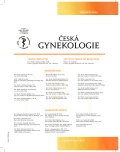Influence of hCG glycosylation on its functions in female reproduction
Authors:
I. Oborná; H. Fingerová
Authors‘ workplace:
Porodnicko-gynekologická klinika LF UP a FNOL, Olomouc, přednosta prof. MUDr. R. Pilka, Ph. D.
Published in:
Ceska Gynekol 2017; 82(1): 42-46
Overview
Objective:
To review contemporary knowledge of the hCG molecule, its isoforms and the importance of glycosylation. Biologic variants and glycoforms of hCG have different biological activities and functions related to the control of menstrual cycle, conception, gestation as well as gynaecologic and non-gynaecologic malignancies.
Design:
A review.
Setting:
Department of Obstetrics and Gynaecology, University Hospital Olomouc.
Methods:
To present own experience and an overview of recent literature in molecular biology, clinical biochemistry and clinical practice.
Conclusion:
Recent knowledge of the role of hCG glycosylation in physiologic and pathologic events in female organism will provide a better understanding of regulation of processes like ovulation (co-operation of pituitary hCG with LH), implantation and hemochorial placentation (invasivity of hyperglycosylated hCG). Some biologic variants and isoforms of hCG are important for the prediction of certain pathologies of pregnancy, prenatal screening of inborn errors (free beta hCG) as well as in the treatment of infertility.
Keywords:
human chorionic gonadotrophin, hCG, hyperglycosylated hCG, hhCG, glycosylation, hCG biologic variants
Sources
1. Birken, S., Kovalevskaya, G., O‘Connor, J. Metabolism of hCG and hLH to multiple urinary forms.Mol Cell Endocrinol,1996, 20, 125, p. 121–131.
2. Brun, S., Leguy, MC., Bruneel, A. et al. hCG in screening for aneuploidy: A possible role for its glycoforms? Placenta, 2014, 35, p. 425–427.
3. Cole, LA. New discoveries on the biology and detection of human chorionic gonadotropin. Reprod Biol Endocrinol, 2009, 26, doi: 10.1186/1477-7827-7-8.
4. Cole, LA. Hyperglycosylated hCG, a review. Placenta, 2010, 31, p. 653–664.
5. Cole, LA. hCG variants, the growth factors which drive human malignancies. Am J Cancer Res, 2012, 2, p. 22–35.
6. Cole, LA. Hyperglycosylated hCG and pregnancy failures. J Reprod Immunol, 2012, 93, p. 119–122.
7. Cole, LA. hCG, the wonder of today´s science. Reprod Biol Endocrinol, 2012, 10, 24, doi: 10.1186/1477-7827-10-24.
8. Dabrowski, F., Grzechocinska, B., Cyganek, A., Wielgos, M. Non trophoblastic source of human chorionic gonadotropin – problem in diagnostic accuracy. Neuroendocrinol Lett, 2015, 36, 4, p. 101–104.
9. Dhaifalah I., Šantavý, J., Hyjánek, J. Screening for chromosomal anomalies inthe first trimester: a report of the first year of prospective screening for chromosomal anomalies in the first trimester in Czech Rep. Biomed Papers, 2006,150, p. 275–278.
10. Ezcurra, D., Humaidan, P. A review of luteinising hormone and human chorionic gonadotropin when used in assisted reproductive technology. Reprod Biol Endocrinol, 2014, 12, doi: 10.1186/1477-7827-12-95.
11. Fournier, T., Guibourdenche, J., Evain-Brion, D. Review: hCGs: Different sources of production, different glycoforms and functions. Placenta, 2015, Supplement 1, 29, p. 60–65.
12. Gehring, C., Siepmann, T., Heudegger, H., Jeschke, U. The controversial role of human chorionic gonadotropin in the development of breast cancer and other types of tumors. Breast, 2016, p. 135–140.
13. Hirose, T. Exogenous stimulation of corpus luteum formation in the rabbit: influence of extracts of human placenta, decidua, fetus, hydatid mole, and corpus luteum on the rabbit gonad. J Jpn Gynecol Soc, 1920, 16, p. 1055–1058.
14. Choi, J., Smitz, J. Luteinizing hormone and human chorionic gonadotropin: distinguishing unique physiologic roles. Gynecol Endocrinol, 2014, 30, 3, p. 174–181.
15. Choi, J., Smitz, J. Luteinizing hormone and human chorionic gonadotropin: Origins of difference. Mol Cell Endocrinol, 2014, 383, p. 203–213.
16. Jiang, X., Dias, J., He, X. Structural biology of glycoprotein hormones and their receptors: Insights to signaling. Mol Cell Endocrinol, 2014, 382, p. 424–451.
17. Midgley, AR, Jr., Jaffe, RB. Regulation of human gonadotropins. II. Disappearance of human chorionic gonadotropinfollowing delivery. J Clin Endocrinol Metab, 1968, 28, p. 1712–1718.
18. Norris, W., Nevers, T., Sharma, S., Kalkunte, S. Review: hCG, preeclampsia and regulatory T cells. Placenta, 2011, 25, p. 180–185.
19. Odell, WD., Griffin, J. Pulsatile secretion of human chorionic gonadotropin in normal adults. N Engl J Med, 1987, 317, p. 1688–1691.
20. Tsampalas, M., Gridelet, V., Berndt, S., et al. Human chorionic gonadotropin: A hormone with immunological and angiogenic properties. J Reprod Immunol, 2010, 85, p. 93–98.
21. Wide, L., Gemzell, CA. An immunological pregnancy test. Acta Endocrinol, 1960, 35, p. 261–267.
Labels
Paediatric gynaecology Gynaecology and obstetrics Reproduction medicineArticle was published in
Czech Gynaecology

2017 Issue 1
Most read in this issue
-
Comparison of vaginal use of micronized progesterone for the luteal support.
Randomized study comparison of Utrogestan and Crinone 8% - Are risk factors in prenatal and perinatal period important for develompent of schizophrenia?
- Sheep as an experimental model in the reaserch of effects of pregnancy, delivery and surgical procedures on the pelvic floor
- Surgical treatment of the female stress urinary incontinence – from needles to mini-slings
